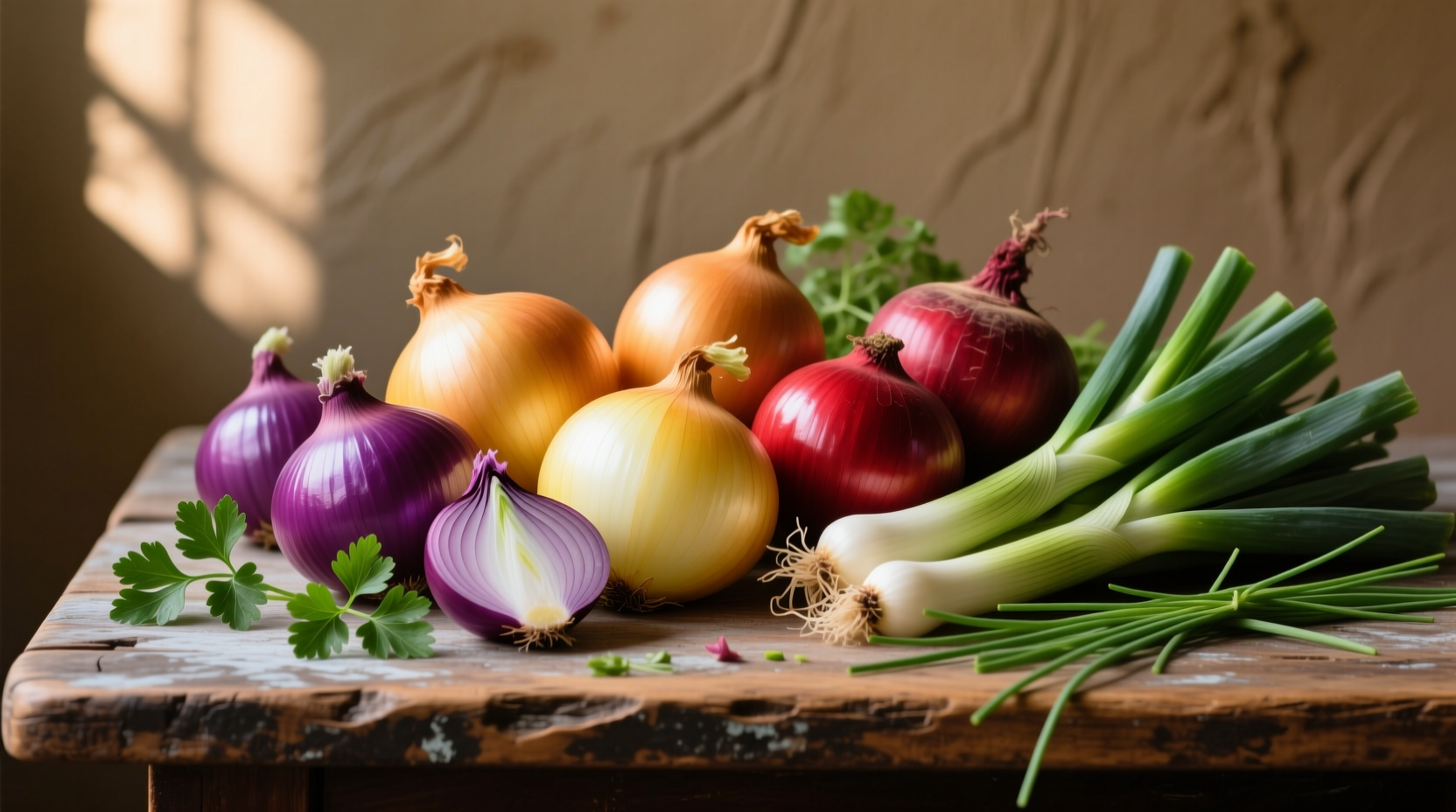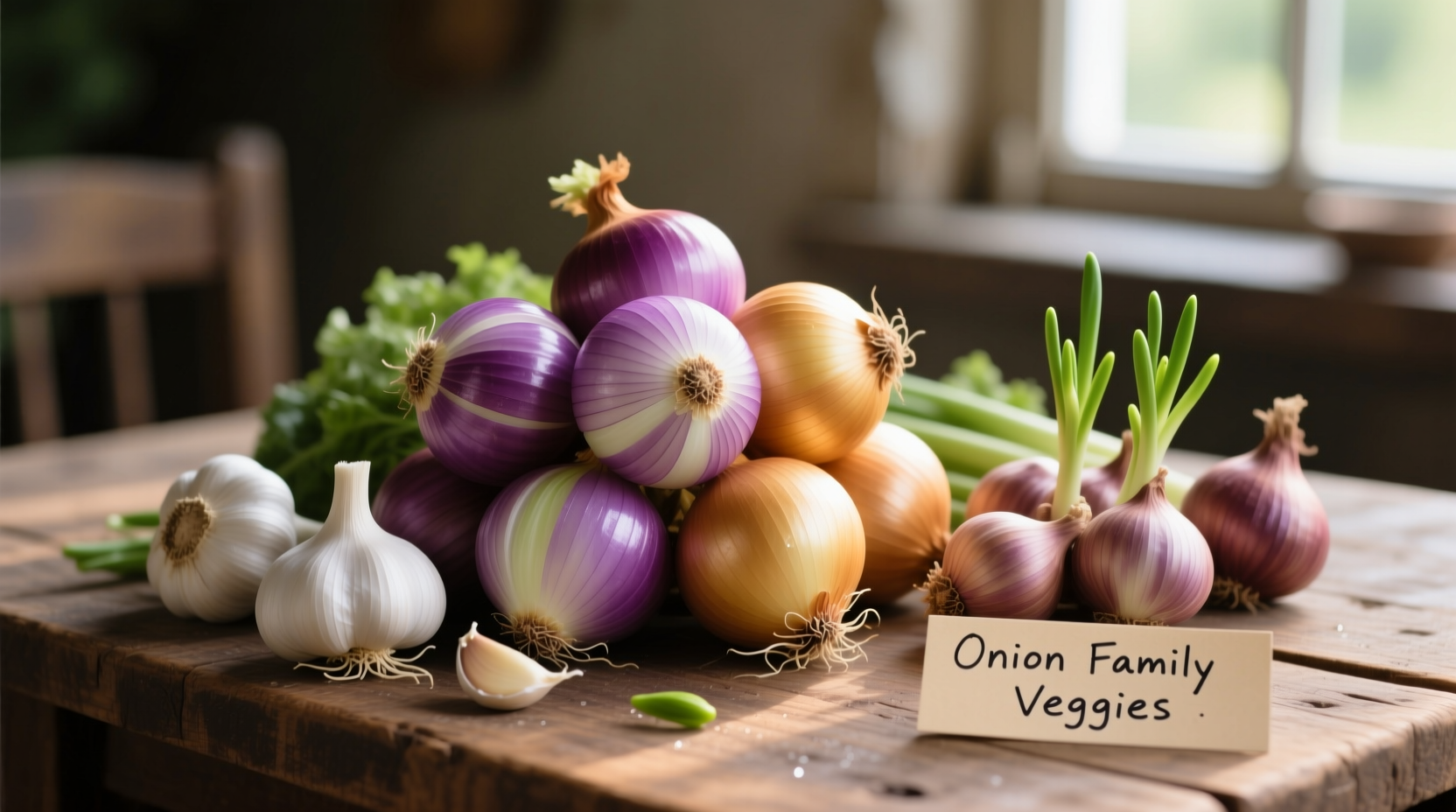The onion family (Allium genus) includes garlic, onions, leeks, chives, scallions, shallots, and ramps. These vegetables share distinctive sulfur compounds that provide both pungent flavors and significant health benefits, including cardiovascular support and immune system enhancement. Understanding their unique properties helps maximize culinary applications and nutritional value.
When you reach for that bunch of green onions or bulb of garlic, you're tapping into one of nature's most versatile vegetable families. The Allium genus delivers unmatched flavor complexity while offering scientifically proven health advantages that make them essential kitchen staples. Whether you're a home cook seeking better flavor control or a gardener wanting to cultivate these powerhouses, understanding the onion family's characteristics transforms how you use these ingredients.
What Defines the Onion Family?
Allium vegetables share distinctive sulfur-containing compounds that create their characteristic aromas and flavors. When cell walls break during cutting or crushing, enzymes convert sulfoxides into sulfenic acids, which then form various sulfur compounds responsible for both the pungency and health benefits. This chemical reaction explains why crushing garlic releases more flavor than slicing, and why letting cut onions rest before cooking develops deeper flavor profiles.
| Allium Vegetable | Distinctive Flavor Profile | Best Culinary Applications | Peak Season |
|---|---|---|---|
| Garlic | Sharp, pungent when raw; nutty, sweet when roasted | Sauces, marinades, roasts | October-March |
| Yellow Onions | Balanced sweet-sharp flavor | Caramelizing, soups, stews | Year-round (peak summer) |
| Shallots | Delicate, subtle garlic-onion fusion | Vinaigrettes, delicate sauces | September-February |
| Leeks | Mild, sweet, grassy | Cream soups, braises | October-March |
| Chives | Delicate onion flavor | Garnishes, egg dishes | Spring-Summer |
Nutritional Power: Science-Backed Health Benefits
Research published in the Journal of Agricultural and Food Chemistry confirms that Allium vegetables contain organosulfur compounds with demonstrated cardiovascular benefits. These compounds help reduce blood pressure and inhibit platelet clotting. The USDA FoodData Central database shows that just one cup of cooked onions provides 22% of your daily vitamin C needs and 12% of vitamin B6 requirements.
Garlic's active compound allicin demonstrates antimicrobial properties validated by multiple studies, including research from the National Center for Biotechnology Information. For maximum benefit, let crushed garlic rest for 10 minutes before cooking to allow full allicin development. This simple technique increases available beneficial compounds by up to 40% compared to immediate cooking.

Culinary Mastery: Transforming Alliums in Your Kitchen
Professional chefs understand that different alliums require specific handling techniques to maximize flavor potential. When working with leeks, proper cleaning is essential—sand trapped between layers can ruin a dish. The correct method involves slicing lengthwise, submerging in cold water, and allowing grit to settle before lifting the clean leeks from the water.
For caramelizing onions, patience delivers rewards. Cooking sliced yellow onions slowly over medium-low heat for 40-50 minutes creates deep umami flavors through the Maillard reaction. Adding a pinch of baking soda (1/16 teaspoon per pound of onions) accelerates the process by raising pH, though traditionalists prefer the slower method for more complex flavor development.
Growing Alliums: From Garden to Table
Home gardeners can successfully grow multiple allium varieties with proper timing. Garlic planting follows a specific seasonal pattern: plant cloves in fall (October in most zones) for harvest the following summer. This cold exposure triggers proper bulb development. According to the USDA Agricultural Research Service, garlic requires 4-8 weeks of temperatures below 50°F (10°C) to initiate bulb formation.
When growing green onions, succession planting every two weeks ensures continuous harvest. Plant seeds ¼ inch deep in well-drained soil with pH 6.0-7.0. Harvest when tops reach 6-8 inches tall, typically 20-30 days after planting. For optimal flavor, harvest in the morning when sugar content peaks.
Understanding Limitations and Considerations
While beneficial for most people, allium vegetables present challenges for some individuals. Those with irritable bowel syndrome (IBS) often experience discomfort from fructans in these vegetables. The Monash University Low FODMAP Diet research shows that green onion tops (the green parts) contain significantly fewer problematic compounds than the white bulbs, offering a compromise for sensitive individuals.
Certain medications interact with allium compounds. People taking blood thinners should maintain consistent allium consumption rather than fluctuating intake, as garlic and onions can enhance blood-thinning effects. Consult your healthcare provider about appropriate consumption levels if you're on anticoagulant therapy.
Historical Context: Alliums Through Time
The cultivation timeline of allium vegetables reveals their enduring importance:
- 5000 BCE: Earliest evidence of onion cultivation in Bronze Age settlements
- 2600 BCE: Egyptian workers building pyramids received garlic rations for strength
- 1st Century CE: Roman naturalist Pliny the Elder documents 20+ medicinal uses for onions
- 1500s: European explorers introduce Alliums to the Americas
- 1800s: Commercial garlic production begins in California
- 1990s: Scientific identification of allicin and other beneficial compounds
Practical Applications for Everyday Cooking
Transform your cooking with these professional techniques:
- Flavor layering: Start with yellow onions for base flavor, finish with chives for fresh top notes
- Temperature control: Sauté garlic at medium heat (never high) to prevent bitterness
- Waste reduction: Simmer onion skins in stock for rich color and additional nutrients
- Flavor preservation: Store cut onions in airtight containers to maintain volatile compounds
When substituting between allium varieties, remember that shallots offer milder flavor than onions (use 1:1 ratio), while garlic powder equals 1 clove per ⅛ teaspoon. For raw applications where sharpness matters, red onions provide vibrant color and slightly milder bite than yellow varieties.











 浙公网安备
33010002000092号
浙公网安备
33010002000092号 浙B2-20120091-4
浙B2-20120091-4